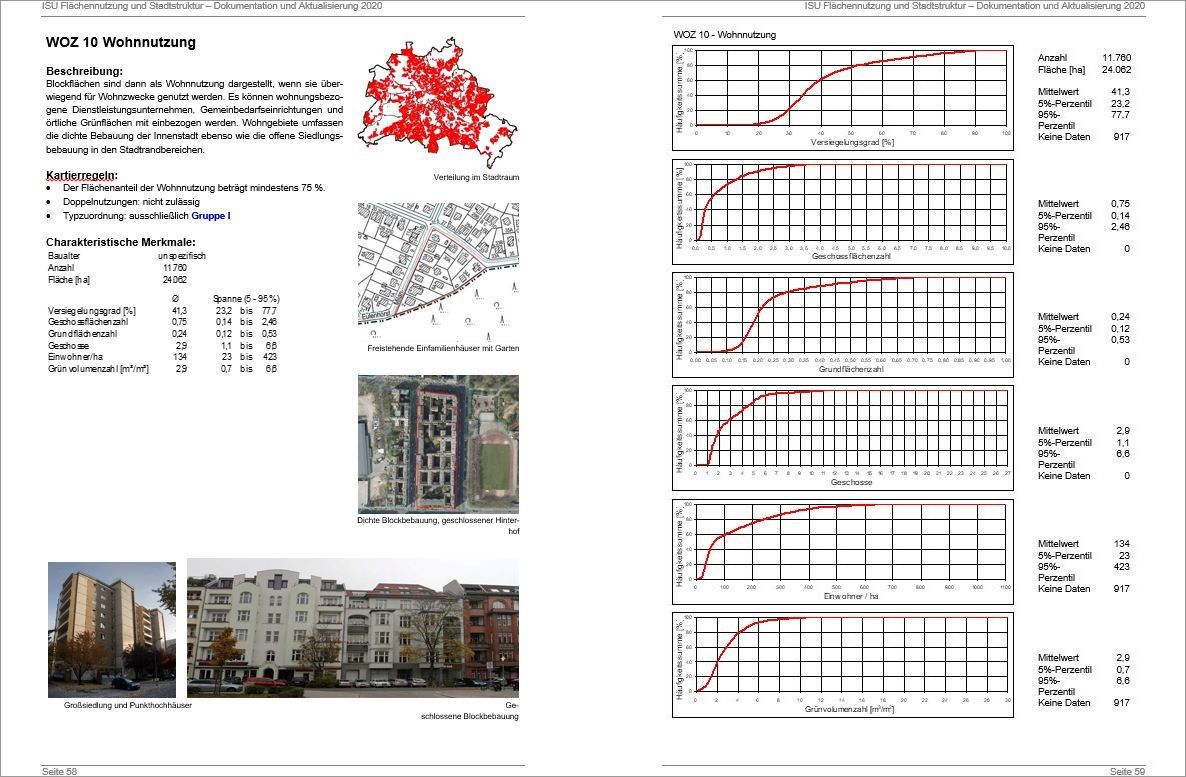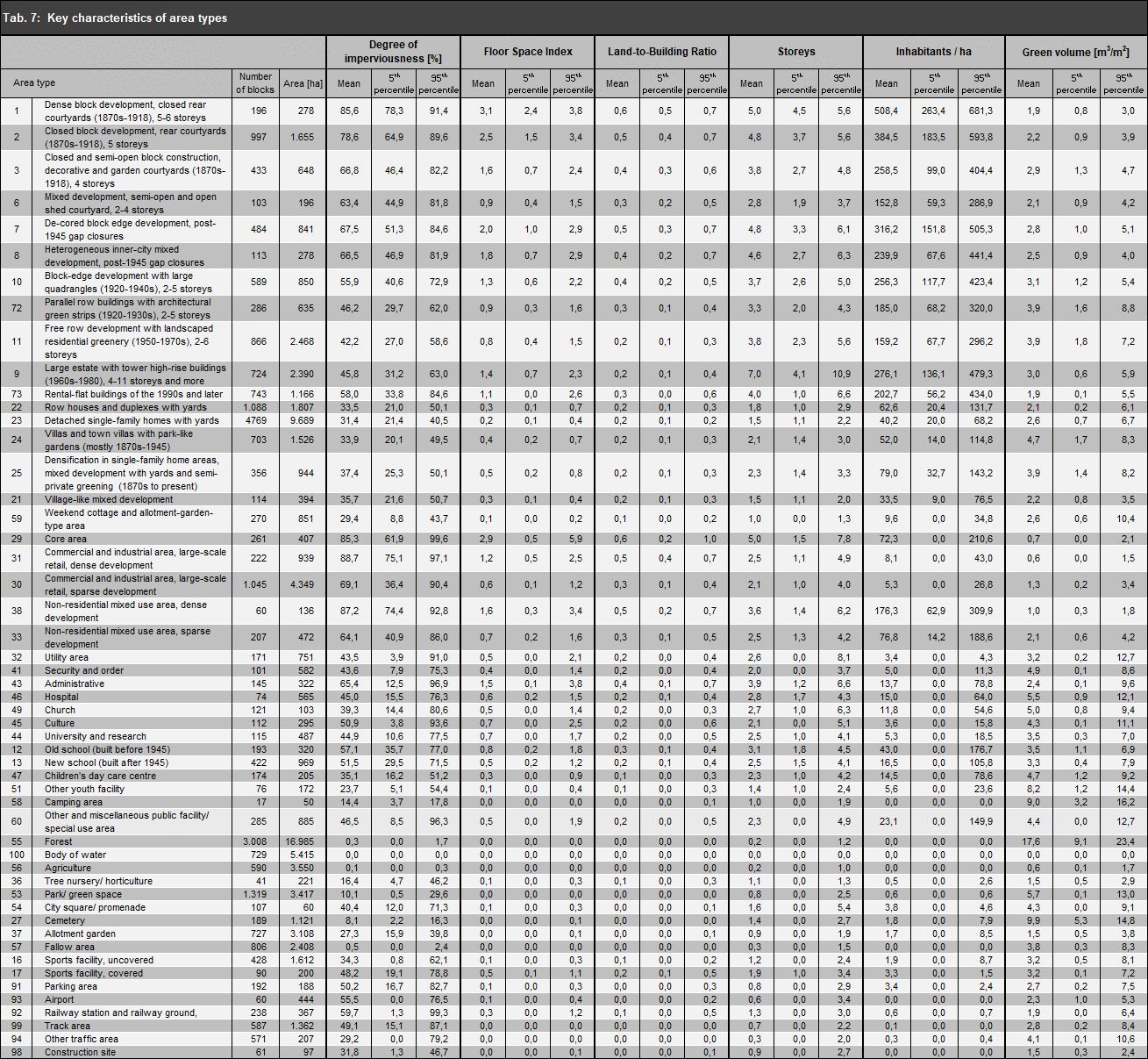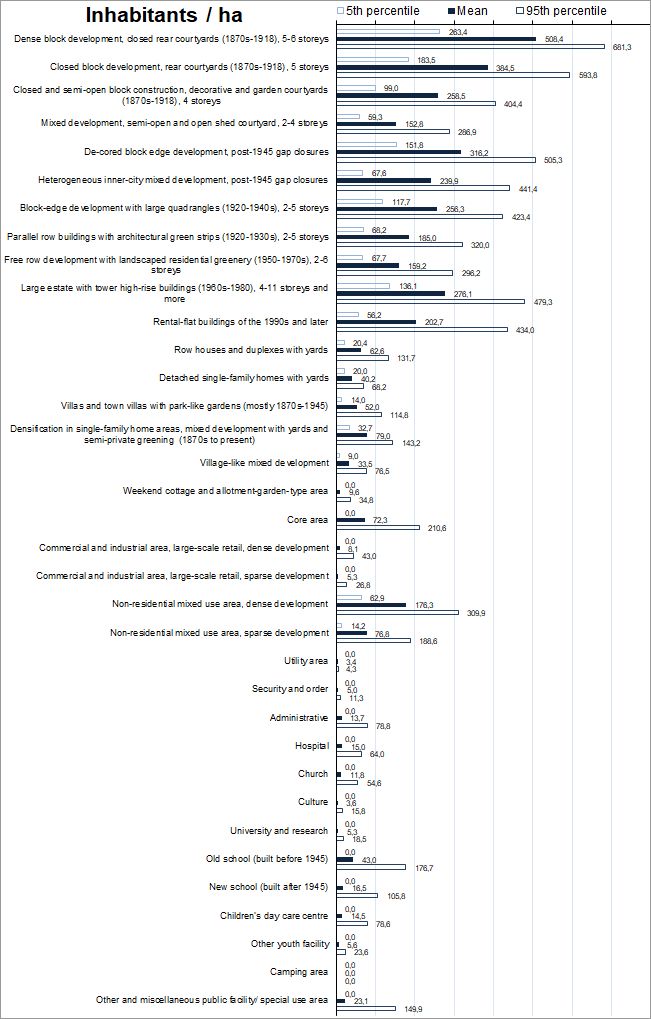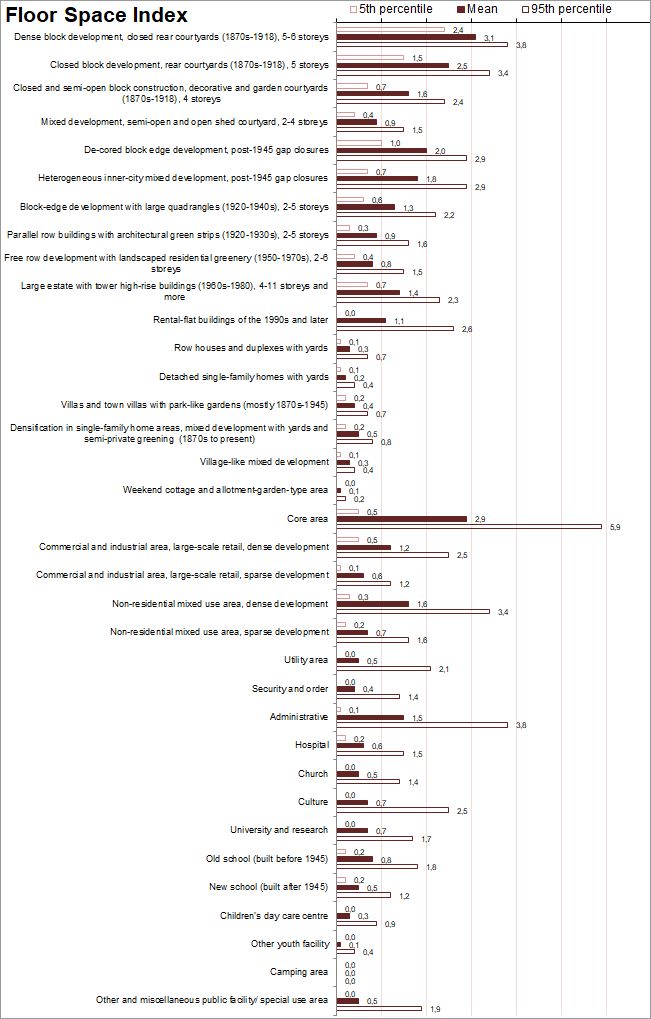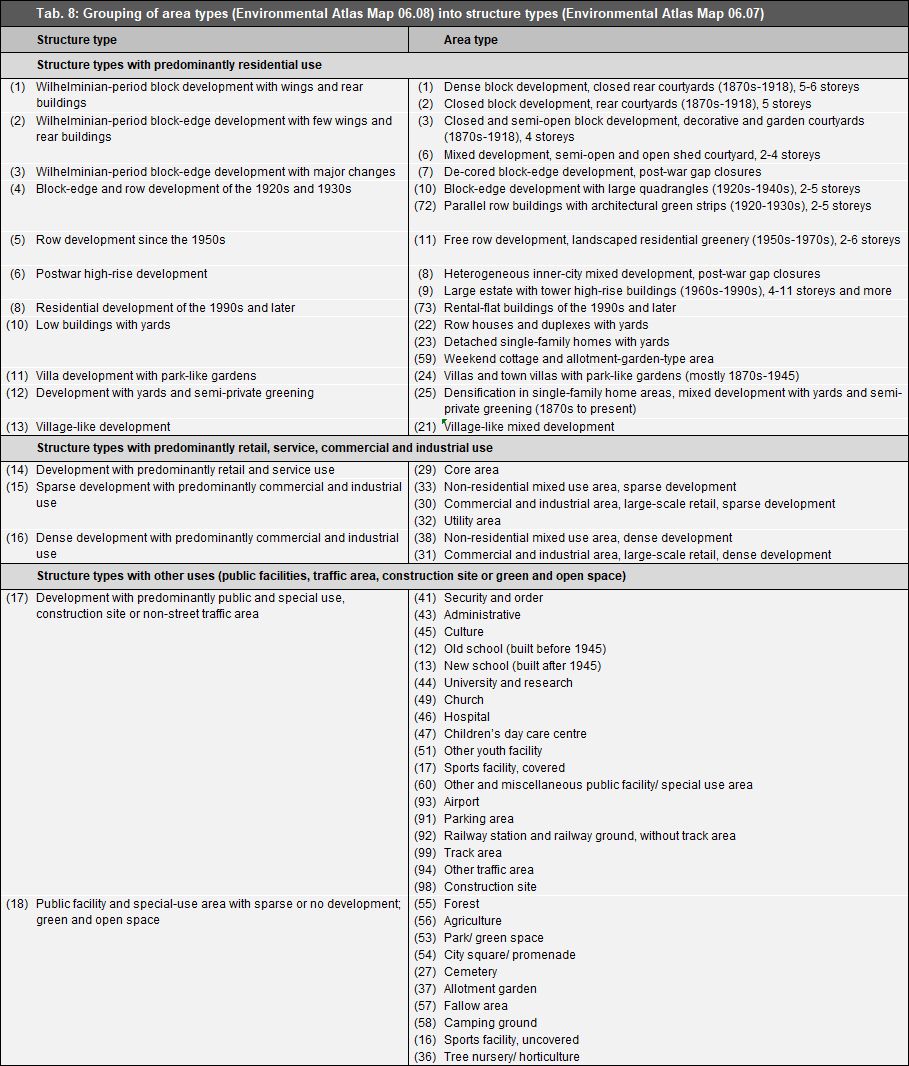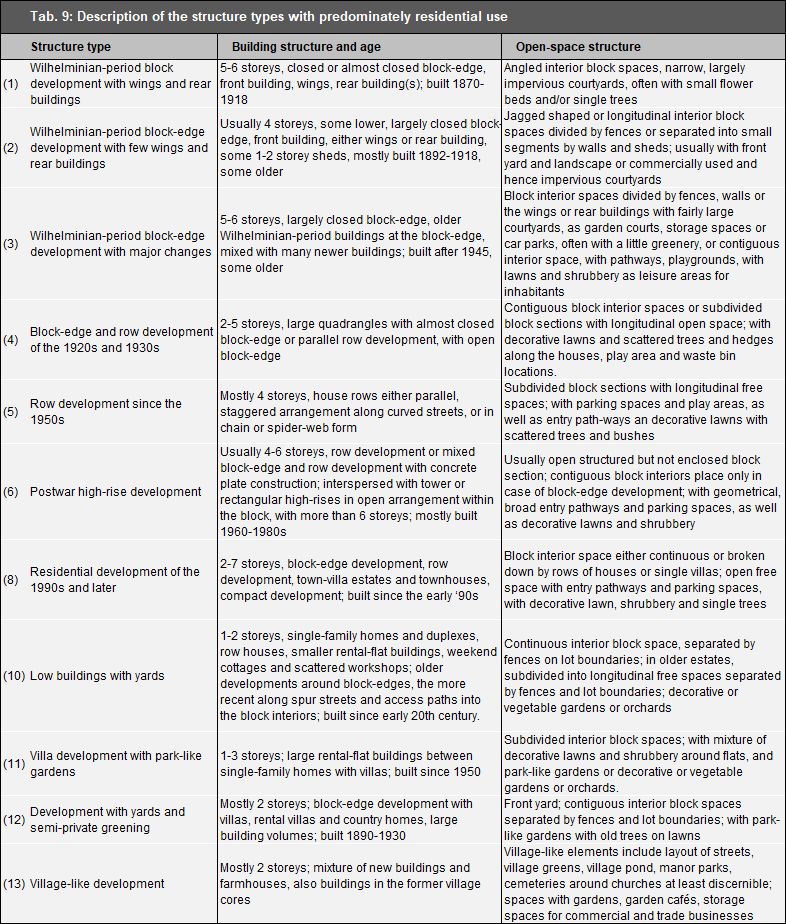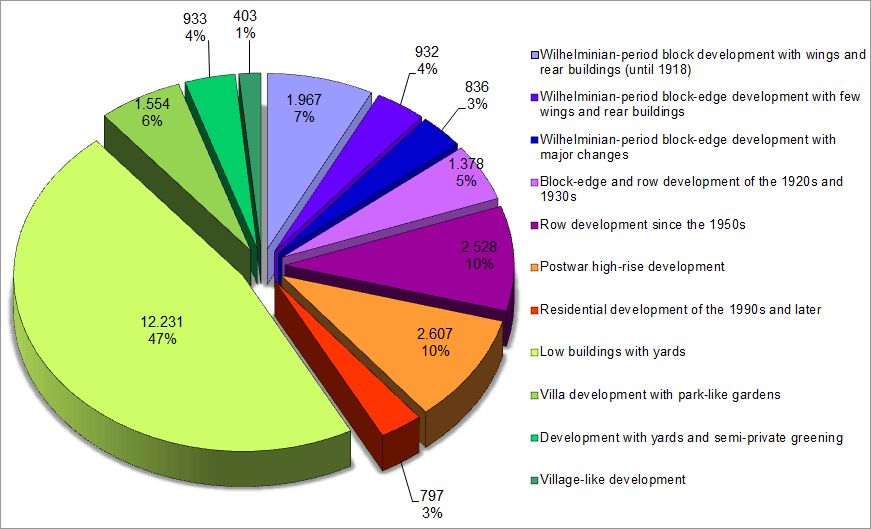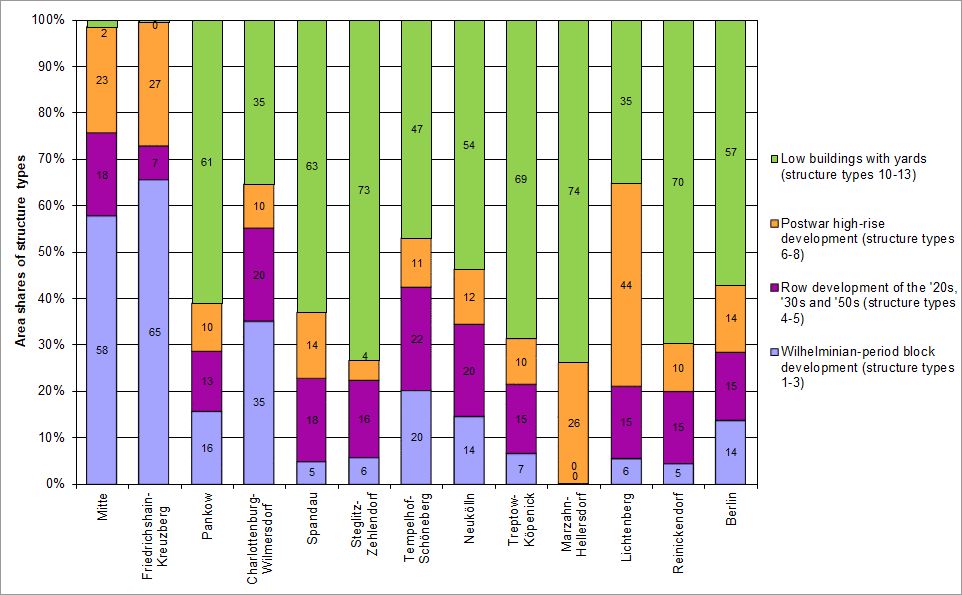Area type 1 “Dense block development, closed rear courtyard (1870s-1918), 5-6 storeys” emerged during the Wilhelminian period (1870-1918) in order to maximise land utilisation for residential purposes. It is largely found inside the City Rail (S-Bahn) Circle Line, and is characterised by close blocks of 5-6-storey buildings. Often, there are still several courtyards, usually entirely surrounded by buildings and connected with one another only by passageways; some of these courtyards are only the size of a light shaft. Sometimes, the courtyards are commercially used; usually however, they merely serve the purpose of access to the wings and rear buildings, and as placement for rubbish bins or bicycles. Not only in the case of commercial utilisation, are these courtyards virtually completely impervious. This area type is thus the most densely built-up and also the most impervious type of residential area.
Area type 2 “Closed block development, rear courtyard (1870s-1918), 5 storeys” designates blocks with primarily closed 5-storey block construction, also built during the same period, also within the Circle Line, for the rapidly growing population of Berlin. The blocks consist largely of old buildings with wings and/or parallel rear buildings. In addition, there are also commercial and industrial buildings, public facilities buildings and restored or new buildings at the block-edges. The courtyards are encompassed by high buildings on several sides, but only rarely on all sides. There are often separated from neighbouring courtyards by walls or fences, so that they together constitute angled interior block spaces. Often, courtyard areas have been connected with one another in the context of renovation measures by means of partial demolitions, and are now used as comprehensive areas for such public facilities as day care centres etc.
In this area type, is characterised by a mix of residential areas and workplaces. It also includes larger commercial operations which require large non-built-up spaces for storage purposes, deliveries, car parks etc.
This category has a somewhat lesser degree of density and imperviousness than the area type “Dense block development”. In better neighbourhoods, the courtyards often have old trees, paved walkways and decorative flower beds. In residential areas with a lesser degree of renovation or a less sophisticated courtyard design, the share of completely impervious and minimally green courtyards is higher.
Area type 3 “Closed and semi-open block development, decorative and garden courtyard (1870s-1918), 4-storeys”, is characterised by 4-storey block construction, often with front yards. The blocks with decorative and garden courtyards were often built during the Wilhelminian period (1870s-1918) in the then-suburbs of Berlin outside the Circle Line (today’s edge of the inner city). These buildings have only wings or only parallel rear buildings, but generally not both. They are characterised by a much sunnier interior block space than is the case for the above two area types; it is usually designed as a garden.
Area type 6 “Mixed development, semi-open and open shed courtyard, 2-4 storeys” is characterised by open mixed structures, particularly at the edge of the inner city and at the edge of the city, and is there especially associated with the old village cores and sub-centres. There are some remains of old structures which were built before 1870, sometimes low, old buildings, sheds and workshops in the courtyards, and these areas are also interspersed with buildings associated with the 4-storey construction of the “decorative and garden courtyard” type, as well as new buildings – both single-family and multifamily houses, and rental-flat buildings – built after 1945. Accordingly, the appearance of these areas is heterogeneous. Their characteristic feature is an interior block space broken down into small parts, often with commercially used workshops, storage areas and parking spaces, but also some privately used vegetable gardens and orchards.
Area type 10 “Block-edge development with large quadrangles (1920-1940s), 2-5 storeys” designates the type of block-edge construction with large residential inner quadrangles, which was typical for the period from the late 1920s to the mid-1940s.
The large quadrangles were formed by the complete or near-complete enclosure by 2 or 5-storey buildings directly on the street line. They were associated with rather well-appointed entry areas, and in some cases semi-public passageways connecting the quadrangles with the streets. The large quadrangles are almost entirely green, and are characterised by an architecturally symmetrical design. In some early estates, the quadrangle was apportioned into residents’ gardens surrounded by hedges. Otherwise, the predominant form was an open space design with lawns and scattered old trees. Particularly characteristic were such “informal” species (birch or willow), which contrasted with the symmetrically arranged, “architecturally-shaped” trees (Lombardy poplar and spruce). Access paths were generally sparingly designed; however, parking garages were in some cases added later. Some interior block spaces that are not under monument protection have been completely reshaped by new
design elements as part of renovation measures.
Area type 72 “Parallel row buildings with architectural green strips (1920s-1930s), 2-5 storeys” describes the row housing of the 1920s and 1930s. During the late 1920s and in the 1930s, the first row houses were built in Berlin. The main purpose was to achieve optimum utilisation of the lots, and to provide much light, air and sun to all the residences. The long rows of 2-5-storey houses were arranged parallel to one another. The free space between the houses was narrow and elongated, and open on the short sides.
The row houses give the streets a spatial closure, since they were not detached in the middle of the lots, as would be common after the 1950s. Rather, they were uniformly arranged at right angles to the street, so that their narrow edges together formed the building line. In some cases, terminal lateral buildings were arranged parallel to the street, so that a mixture of row and block-edge construction emerged, resulting in variegated exterior spaces. Passageways, vistas and jutties were used to visually break up the appearance of these streets. Moreover, the street space was varied by placing the buildings slightly in front of or behind the building line, and with local extensions. Front yards were almost always provided.
Area type 8 “Heterogeneous inner-city mixed development, post-war gap closure” is also located within the residential neighbourhoods built during the Wilhelminian period. Here, unlike the previous area types, high-rise buildings with rental flats and offices were often built as rows or single towers in the block areas, often with no regard for the historic building lines or building heights of those streets. Remainders of Wilhelminian-period buildings are only sporadically present. The blocks have neither block interior spaces nor closed semiprivate courtyard areas. The non-enclosed open areas serve as car parks in the form of underground or surface parking. The other open areas are largely designed as non-usable green fringe.
Area type 7 “De-cored block-edge development, post-war gap closure” is scattered throughout the Wilhelminian-period residential neighbourhoods in the inner-city and the inner-city edge. The old buildings destroyed in the Second World War were replaced by the reconstruction of those buildings, or by new buildings in the gaps. Generally, the new buildings were placed along the same building lines as the old ones, so that this area type is largely characterised by closed block-edge construction, which is however sometimes interrupted by driveways, car parks, gaps, etc.
In the context of modernisation with the new construction of front buildings, it was not uncommon for all lateral and rear buildings, as well as sheds, to be torn down. The result was a block interior area that was more open than the original structure; generally, it is subdivided at the lot boundaries by fences. In addition to the old structuring of the courtyards, these areas are often dominated by car parks surrounded by green space, such as lawns and bushes. In some cases, however, relatively large interior spaces were created, which have been designed as leisure spaces for the inhabitants, with green spaces and lawns, playgrounds and benches, or with such public facilities as day care centres.
Area type 73 “Rental-flat buildings of the 1990s and later” includes all new multi-storey residential buildings built since the beginning of the 1990s, which are considerably different from the typical large estates (cf. area type 9 “Large estate with tower high-rise buildings (1960s-1990s)”), and include a wide range of urban development structures, e.g. block-edge, row houses, town villas and townhouses. For the most part, these are major residential development projects of the 1990s and the first years of the 21st century, which have been carried out in the context of major urban development measures (Wasserstadt Berlin-Oberhavel, Rummelsburger Bucht) and other large projects (Karow-Nord, Buchholz etc.). By contrast, single-family housing areas, row house and duplex estates built during the 1990s and later are assigned to the area types with unspecified building age (area types 22 “Row houses and duplex with yards” and 23 “Detached single-family
homes with yards”).
Open spaces and interior courtyard areas of the estates built since the 1990s are often designed as semi-public green spaces with playgrounds and leisure areas; the ground-floor flats often have terraces or small garden areas. Car parking space is increasingly being provided in underground garages.
Moreover, the estates built since the 1990s have a relatively energy-saving, in some cases ecologically oriented type of construction, thanks to current standards (relatively good insulation, in some cases passive houses, rainwater seepage, greened roofs, etc.).
The buildings of area type 9 “Large estate with tower high-rise buildings (1960s-1990s), 4-11 storeys and more” appeared between the late 1960s and the end of the 1990s. Often, these were comprehensive large-scale residential areas at the edge of the city (satellite towns), mostly built by concrete plate construction. Smaller estates with row or block development can be found in the sub-centres and in the inner-city area. In the eastern part of the city, concrete plate construction was sporadically used even within the historic structural area.
Typically, unlike the following area type 11 “Free row development with landscaped residential greenery (1950s-1970s)”, various building heights and designs were used within the same estate. Often, these were 4–8-storey, semi-open block-edge developments, or mixtures of block-edge and row developments, which were in some cases combined with single tower high-rises or high-rise chains of ten storeys or more. Especially in the major estates, the buildings were often placed with no reference whatever to the streets, so that there is no homogeneous spatial street structure.
Large, non-enclosed open spaces often exist between the buildings, surrounded by large numbers of surface car parks. The pervious surfaces are largely covered by lawns and shrubbery.
As part of the Berlin-wide programme “Strengthening Berlin’s large housing estates (Stärkung Berliner Großsiedlungen, SenStadtWohn 2021b, only in German), increased efforts have been and are being made to upgrade the green spaces of the large estates in order to improve their amenity and ecological quality.
Area type 11 “Free row development with landscaped residential greenery (1950s-1970s), 2-6 storeys” emerged during the post-war period, primarily during the ‘50s through the ‘70s, in the context of the reconstruction programmes. The elongated mostly 4-storey blocks of houses arranged in rows were for the most part built as coherent estates in former residential areas badly destroyed in the war in the inner-city, and along the edges of the densely built-up areas at the inner-city edge.
Unlike the row housing of the ‘20s and ‘30s, the construction was no longer oriented directly toward the existing street grid. It is often oriented in an east-westerly direction, in order to provide more sunlight for the flats, but is no longer as strictly parallel as the rows built during the ‘20s and ‘30s. In the later years, the rows were often built in a staggered and shifted arrangement, or arbitrarily lined up along a curving pattern of streets. During the 1970s, designs in chain or spider-web form also emerged. By contrast with the area type “Large estate with tower high-rise buildings” each estate generally had uniform designs and heights.

